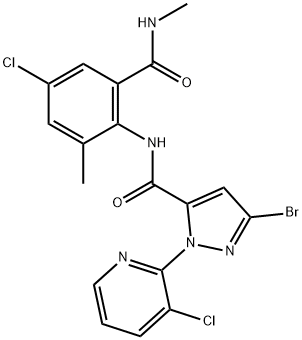500008-45-7

Product Name:
Chlorantraniliprole
Formula:
C18H14BrCl2N5O2
Synonyms:
3-Bromo-N-[4-chloro-2-methyl-6-[(methylamino)carbonyl]phenyl]-1-(3-chloro-2-pyridinyl)-1H-pyrazole-5-carboxamide;3-Bromo-4′-chloro-1-(3-chloro-2-pyridyl)-2′-methyl-6′-(methylcarbamoyl)pyrazole-5-carboxanilide;DPX E2Y45
Inquiry
CHEMICAL AND PHYSICAL PROPERTIES
| Color/Form | Fine, crystalline, off-white powder |
|---|---|
| Melting Point | 208-210 °C |
| Solubility | Solubility in acetone 3.4, acetonitrile 0.71, dichloromethane 2.48, ethyl acetate 1.14, methanol 1.71 (all in g/L) |
| Density | 1.1589 (95.9%); 1.507 (99.2%) at 20 °C |
| LogP | log Kow = 2.76 |
| Stability/Shelf Life | Stable at normal temperatures and storage conditions. /DuPont Dermacor X-100 Seed Treatment/ |
| pH | pH 5.77 at 20 °C |
| Dissociation Constants | pKa = 10.88 |
| Other Experimental Properties | MP: 200-202 °C; density: 1.5189 at 20 °C. Technical is >93% /Technical/ |
SAFETY INFORMATION
| Signal word | Warning |
|---|---|
| Pictogram(s) |
 Environment GHS09 |
| GHS Hazard Statements |
H410:Hazardous to the aquatic environment, long-term hazard |
| Precautionary Statement Codes |
P273:Avoid release to the environment. P391:Collect spillage. Hazardous to the aquatic environment P501:Dispose of contents/container to..… |
COMPUTED DESCRIPTORS
| Molecular Weight | 483.1 g/mol |
|---|---|
| XLogP3 | 4.8 |
| Hydrogen Bond Donor Count | 2 |
| Hydrogen Bond Acceptor Count | 4 |
| Rotatable Bond Count | 4 |
| Exact Mass | 480.97079 g/mol |
| Monoisotopic Mass | 480.97079 g/mol |
| Topological Polar Surface Area | 88.9 Ų |
| Heavy Atom Count | 28 |
| Formal Charge | 0 |
| Complexity | 586 |
| Isotope Atom Count | 0 |
| Defined Atom Stereocenter Count | 0 |
| Undefined Atom Stereocenter Count | 0 |
| Defined Bond Stereocenter Count | 0 |
| Undefined Bond Stereocenter Count | 0 |
| Covalently-Bonded Unit Count | 1 |
| Compound Is Canonicalized | Yes |
PRODUCT INTRODUCTION
description
Chlorantraniliprole is a carboxamide resulting from the formal condensation of the carboxylic acid group of 3-bromo-1-(3-chloropyridin-2-yl)-1H-pyrazole-5-carboxylic acid with the primary amino group of 2-amino-5-chloro-N,3-dimethylbenzamide. The first of the anthranilic diamide insecticides, it is a ryanodine receptor activator and is used to protect a wide variety of crops, including corn, cotton, grapes, rice and potatoes. It has a role as a ryanodine receptor agonist. It is an organobromine compound, a member of pyridines, a member of pyrazoles, a pyrazole insecticide, a member of monochlorobenzenes and a secondary carboxamide.
